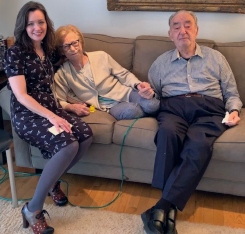VITAS Advantage: Case Study on High-Acuity Care for Residents of Senior Living Communities
Case Study: Patient with Congestive Heart Failure
AF* is an 84-year-old nursing home resident with congestive heart failure who has been hospitalized for a third time in the past three months. One week after her last hospitalization that included three days in the intensive care unit, she returns to the emergency department with shortness of breath, worsening CHF symptoms, lethargy, and ongoing weight loss.
In consultation with the ED physician, AF’s family agrees to a discharge plan for hospice care in AF’s nursing home.
Over the next five weeks, AF receives regular visits in the nursing home from a hospice aide for personal care, and a hospice nurse for symptom/medication management and a goals-of-care conversation that results in a DNR order.
The interdisciplinary hospice team creates an individualized care plan and supports facility staff in managing AF’s cardiac symptoms, including visits by a hospice respiratory therapist and one instance of 24-hour Intensive Comfort Care® at AF’s bedside to manage shortness of breath, anxiety, and pain. A social worker and chaplain support AF’s family with funeral arrangements and anticipatory grief. Six weeks after returning to the nursing home, AF dies peacefully with her family and grandson at her side.
*These initials represent an anonymized patient and are used for the purposes of education only.
Despite High Symptom Burden, Nursing Home Residents Are Unlikely to Receive Hospice, Palliative Care
The authors of a research letter published in JAMA Internal Medicine report that nearly 70% of nursing home (NH) residents in their study cohort were found to be eligible for palliative care (PC), yet not one was receiving such care, and only two were enrolled in hospice.
“Increasing access to [palliative care] for nursing home residents is critical.”
“Our work suggests that, although most nursing home residents report high symptom burden and are eligible for PC services, they are not receiving any formal interdisciplinary PC,” write the authors. “Furthermore, only 3.8% of residents had a MDS [Minimum Data Set]-documented prognosis of less than six months survival, an unlikely scenario considering the health status of these residents.”
Palliative care, with its emphasis on symptom/pain management and comfort care at any stage of a chronic illness, is a medical specialty that includes hospice care.
The Centers for Disease Control and Prevention predicts that by 2030, 40% of Americans will die in NHs. Yet little is known of the PC needs of NH residents, and despite increasing yearly costs, NH care “has been associated with poor symptom control, low family satisfaction, and burdensome and unnecessary care transitions in the last months of life,” note the authors.
Investigators analyzed data gathered in 2015 from a PC quality initiative conducted in three northern California nursing homes that were participating in a broader quality improvement initiative to reduce hospital readmissions. Of the 228 residents studied, 157 (69%) were PC-eligible.
Among PC-eligible residents overall:
- The most common diagnosis was Alzheimer’s disease/dementia (47.4%), followed by congestive heart failure (23.7%), chronic obstructive pulmonary disease (16.7%), and cancer (8.3%), which represent four of the top five diagnoses for hospice care in 2018, according to the National Hospice and Palliative Care Organization
- 84.1% required extensive or total assistance in ≥ 3 activities of daily living
- 32.7% were in pain
- The mean number of medications was 15.2 (range: 3 to 34)
- 98.7% had completed a POLST (Physician Order for Life-Sustaining Treatment) form (47.7% full treatment; 27.5% limited treatment; 24.8% comfort-focused treatment)
- Nearly half (47.9%) had a hospital readmission within the past year
- Not one resident was receiving PC
- Only 3.8% had an MDS-documented prognosis of 6 months or less, and even fewer (1.3%) were enrolled in hospice
“Increasing access to PC for nursing home residents is critical given mounting evidence confirming that PC care in the NH setting is associated with improved care quality and satisfaction, enhanced symptom management, and fewer emergency department visits, particularly when such care is initiated earlier in the disease course,” the authors write.
“Early identification of PC-eligible residents can help health systems target efforts designed to meet documented patient preferences, improve symptom management, ensure timely referral to hospice care, and reduce burdensome care transitions at the end of life.”
A major barrier to access to PC in NHs is the lack of PC-trained clinicians able to care for patients in these settings, note the authors. They suggest that telehealth and other novel strategies be explored and implemented to increase access to much-needed palliative and hospice care for patients with chronic and advanced illnesses.
The VITAS Advantage Supports Aging in Place for Residents With Advanced Illness
VITAS specializes in complex modalities for patients who require high-acuity care, a resource that enables senior living community residents to age in place in their preferred setting. For senior living community professionals, hospice care in facilities:
- Ensures that the care residents receive matches the end-of-life care they prefer
- Relieves burdens and stress on staff by incorporating hospice resources, expertise, 24/7 availability, and team members into residents’ daily care plans
- Reduces readmissions of residents to the hospital or emergency department and improves overall metrics for long- and short-stay quality of care, and patient/family satisfaction.
Source: Stephens, C & Hunt, L. (2017) Palliative Care Eligibility, Symptom Burden, and Quality-of-Life Ratings in Nursing Home Residents. JAMA Internal Medicine, DOI: 10.1001/jamainternmed.2017.6299
Is your patient ready for hospice?
Meet the VITAS Hospice Team

Physician
The physician closely monitors the progression of the patient’s illness, prescribes appropriate medications and coordinates care with other members of the team.
Hospice Nurse
The hospice nurse is skilled in assessing and managing pain and other symptoms. A nurse may also help with personal care.
Hospice Aide
Hospice aides provide personal care to the patient. They are also the “eyes and ears” for the rest of the hospice team.
Social Worker
The social worker acts as a friendly and skilled listener and provides emotional support.
Volunteer
The hospice volunteer can bring music or a Paw Pals animal companion, and spends quality time with the patient and family.
Chaplain
The chaplain ministers to the spiritual needs of patients and families of all faiths, and can work with their clergy.

